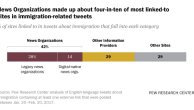Summary of Findings

As efforts to stop a major underwater oil leak faltered and President Obama traveled to Louisiana to assess the early damage, the crisis in the Gulf of Mexico grabbed public attention and dominated media coverage last week.
More than half of Americans (55%) say they followed news about the oil leak very closely. Close to six-in-ten (58%) say they followed this news more closely than any other major story, according to the latest News Interest Index survey, conducted May 27-30 among 1,001 adults by the Pew Research Center for the People & the Press. One week earlier, 47% said they were following news about the leak very closely.
News about the unfolding environmental disaster accounted for 38% of media coverage last week. That is more than double the share of newshole devoted to the story one week earlier (18%), when the media also focused heavily on the 2010 midterm elections (also 18%).
The public’s attention to the spill rivals attention paid to the Haiti earthquake earlier this year. Just days after the Jan. 12 earthquake, 60% said they followed news about that disaster very closely; 57% said this was the story they were following most closely.
Interest in the oil spill, on the other hand, grew in the weeks following the deadly oil rig explosion on April 20. That first week, about two-in-ten (21%) said they were following the explosion very closely. One week later, as the leak continued to grow, 44% said they were tracking the worsening spill that closely. The number rose to 58% the week of May 13-16 as energy giant BP could not stop the flow of oil into the gulf. The number dipped slightly two weeks ago to 47% but jumped again last week as new efforts to stop the leak failed, more oil hit the coastline and debate grew about the Obama administration’s handling of the crisis.

Attentiveness rivals interest in several other major disasters. In May 1989, 52% of the public said they were very closely following news about the massive oil spill caused by the March 24 crash of the Exxon Valdez tanker in Alaska’s Prince William Sound. In early October 2005, 73% said they were very closely following news about the devastation wrought in New Orleans and elsewhere on the Gulf Coast by hurricanes Katrina and Rita. Katrina had hit the coast on Aug. 29, leading to massive flooding, devastation and dislocation.
This April, 33% said they were very closely following the West Virginia coal mine explosion that left 29 dead.
Last week, interest in the oil leak was high across demographic and political groups. Six-in-ten men say they followed this news very closely, slightly higher than the 51% of women who say this. There were no differences across educational levels (55% each) and only slight differences among partisans. Six-in-ten Democrats say they followed news about the spill very closely, compared with 52% of Republicans. Among independents, 55% followed this news very closely.
The Week’s News

Though most Americans focused on the oil spill last week, other stories also grabbed the public’s attention. More than four-in-ten (43%) say they followed reports about the condition of the economy very closely. This was the most closely followed story for 11%. The media devoted 6% of coverage to news about the economy, according to a separate analysis by the Pew Research Center’s Project for Excellence in Journalism (PEJ).
About three-in-ten (29%) say they very closely followed President Obama’s announcement that he would send 1,200 National Guard troops to the Mexican border, a component in the long-running debate over immigration legislation; 7% say they followed this news more closely than any other major story. Reporting on this accounted for 5% of the newshole examined by PEJ.
About two-in-ten (19%) say they very closely followed news about tensions between North Korea and South Korea; 3% say this was the story they followed most closely. News about the tensions made up 3% of coverage.
Just 16% say they very closely followed the debate in Congress over whether to repeal the “Don’t Ask, Don’t Tell” policy concerning gays in the military. The full House and a Senate panel both voted to end the policy; 3% say they followed this news more closely than any other major story. The media devoted 2% of coverage to this story.
About one-in-ten (9%) very closely followed news about unrest in Jamaica after attempts to arrest a major drug dealer. The story accounted for 1% of coverage and just 1% say this was the story they followed most closely.

These findings are based on the most recent installment of the weekly News Interest Index, an ongoing project of the Pew Research Center for the People & the Press. The index, building on the Center’s longstanding research into public attentiveness to major news stories, examines news interest as it relates to the news media’s coverage. The weekly survey is conducted in conjunction with The Project for Excellence in Journalism’s News Coverage Index, which monitors the news reported by major newspaper, television, radio and online news outlets on an ongoing basis. In the most recent week, data relating to news coverage were collected May 24-30, and survey data measuring public interest in the top news stories of the week were collected May 27-30, from a nationally representative sample of 1,001 adults.
About the News Interest Index
The News Interest Index is a weekly survey conducted by the Pew Research Center for the People & the Press aimed at gauging the public’s interest in and reaction to major news events. This project has been undertaken in conjunction with the Project for Excellence in Journalism’s News Coverage Index, an ongoing content analysis of the news. The News Coverage Index catalogues the news from top news organizations across five major sectors of the media: newspapers, network television, cable television, radio and the internet. Each week (from Monday through Sunday) PEJ compiles this data to identify the top stories for the week. (For more information about the Project for Excellence in Journalism’s News Coverage Index, go to www.pewresearch.org/pewresearch-org/journalism.) The News Interest Index survey collects data from Friday through Monday to gauge public interest in the most covered stories of the week.
Results for this survey are based on telephone interviews conducted under the direction of Princeton Survey Research Associates International among a national sample of 1,001 adults living in the continental United States, 18 years of age or older, from May 27-30, 2010 (670 respondents were interviewed on a landline telephone, and 331 were interviewed on a cell phone, including 104 who had no landline telephone). Both the landline and cell phone samples were provided by Survey Sampling International. Interviews were conducted in English.
The combined landline and cell phone sample are weighted using an iterative technique that matches gender, age, education, race, Hispanic origin, region, and population density to parameters from the March 2009 Census Bureau’s Current Population Survey. The sample is also weighted to match current patterns of telephone status based on extrapolations from the 2009 National Health Interview Survey. The weighting procedure also accounts for the fact that respondents with both landline and cell phones have a greater probability of being included in the combined sample and adjusts for household size within the landline sa mple. Sampling errors and statistical tests of significance take into account the effect of weighting. The following table shows the error attributable to sampling that would be expected at the 95% level of confidence for different groups in the survey:

In addition to sampling error, one should bear in mind that question wording and practical difficulties in conducting surveys can introduce error or bias into the findings of opinion polls




